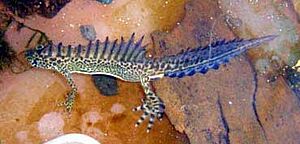Northern facts for kids
Quick facts for kids Northern |
|
|---|---|
 |
|
| Conservation status | |
| Scientific classification | |
| Genus: |
Ommatotriton
|
| Species: |
ophryticus
|
| Synonyms | |
|
Triton ophryticus Berthold, 1846 |
|
The northern banded newt (Ommatotriton ophryticus) is a type of newt that belongs to the Salamandridae family. You can find this cool creature in northeastern Turkey and the western Caucasus region. This includes countries like Georgia, Armenia, and southern Russia.
Contents
About the Northern Banded Newt
How Scientists Classify Newts
For a long time, the northern banded newt was thought to be a subspecies of another newt called Ommatotriton vittatus. But in 2005, a group of scientists led by Litvinchuk decided it was unique enough to be its own full species. This means they gave it its own special species name!
What Does it Look Like?
The northern banded newt has a tail that is about the same length as its body and head combined. Its legs and "fingers" (digits) are quite long, especially on the males. Its skin can feel almost smooth or a little bumpy.
When this newt is living on land, its back is usually reddish. But when it moves into the water, its back and sides change to a bronze-olive or olive-brown color. You might also see small dark spots on its back and a light band on its sides, often outlined with dark stripes. Its belly is a clear yellow or orange color.
During the breeding season, male newts get a special look! They grow a very tall, wavy crest along their back and tail. Their bodies become yellowish or brownish with dark stripes. Their tails also get dark spots on top and blue or greenish spots elsewhere.
Where it Lives and How it Reproduces
The northern banded newt usually lives in high places, often more than 1,200 meters (about 4,000 feet) above sea level. It likes to live in different kinds of forests, like those with pine trees, mixed trees, or trees that lose their leaves. You can also find it in open, grassy areas high in the mountains.
When it's time to lay eggs, these newts use many different types of water bodies. This can be anything from small, temporary ponds that dry up to larger lakes.
Most of the time, the newt sleeps through winter (this is called hibernation) on land. However, sometimes newts that are ready to breed can be found in the water as early as January! The land where they live can sometimes be quite dry.
Protecting the Northern Banded Newt
Even though the northern banded newt can be common in some areas, it's spread out unevenly across its home range. This newt faces several challenges that threaten its survival.
One big problem is habitat loss. This happens when forests are cut down, dams are built (which change wetlands), and cities grow. Too much overgrazing by farm animals can also harm their homes. Pollution is another threat.
Also, new animals like introduced raccoons can eat the newts, which is a major danger. Sadly, some northern banded newts are also collected and sold as pets. Protecting their homes and reducing these threats are important steps to help these unique newts survive.
Images for kids



